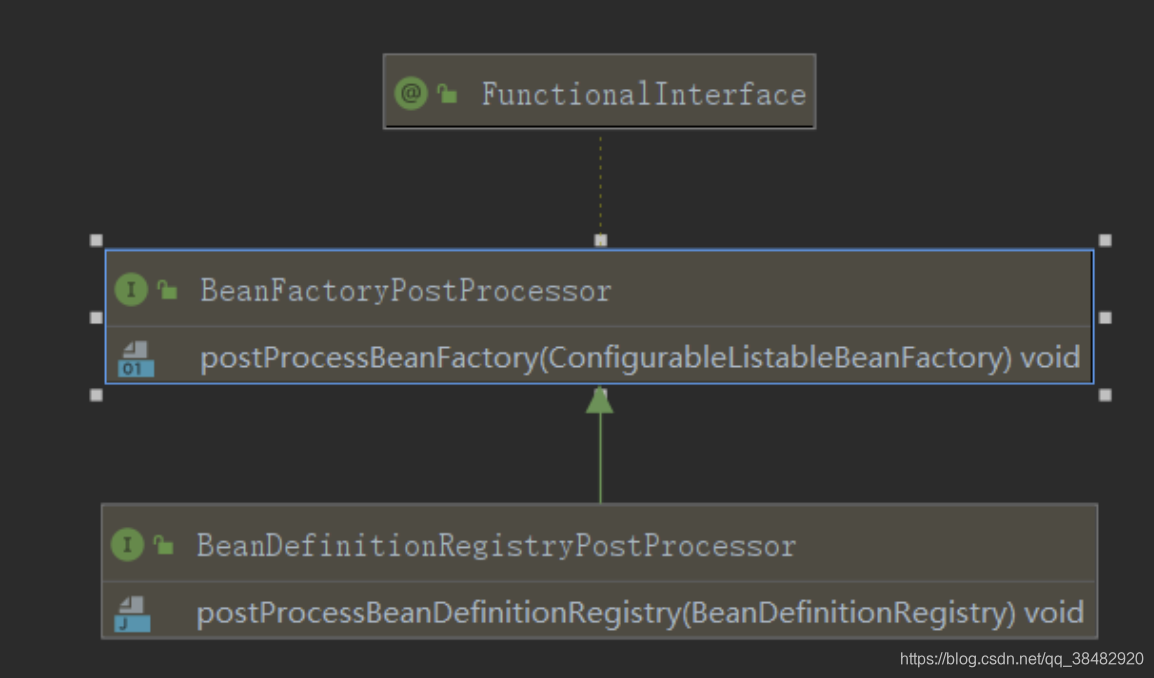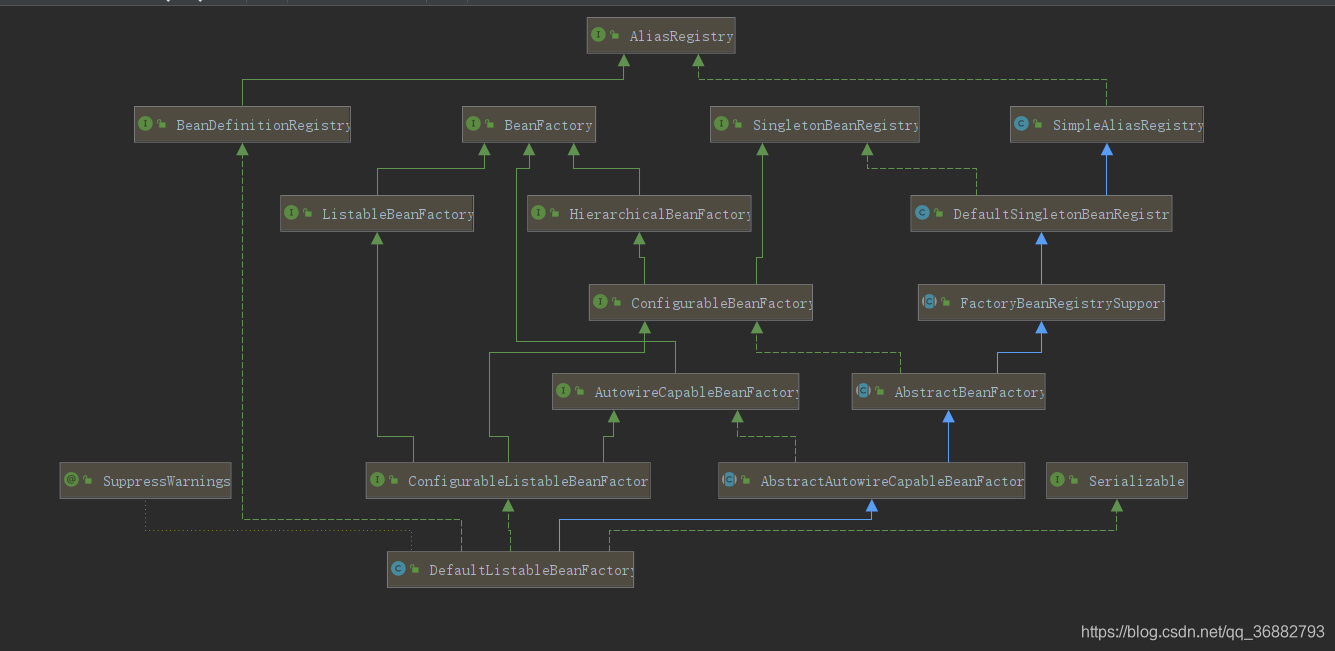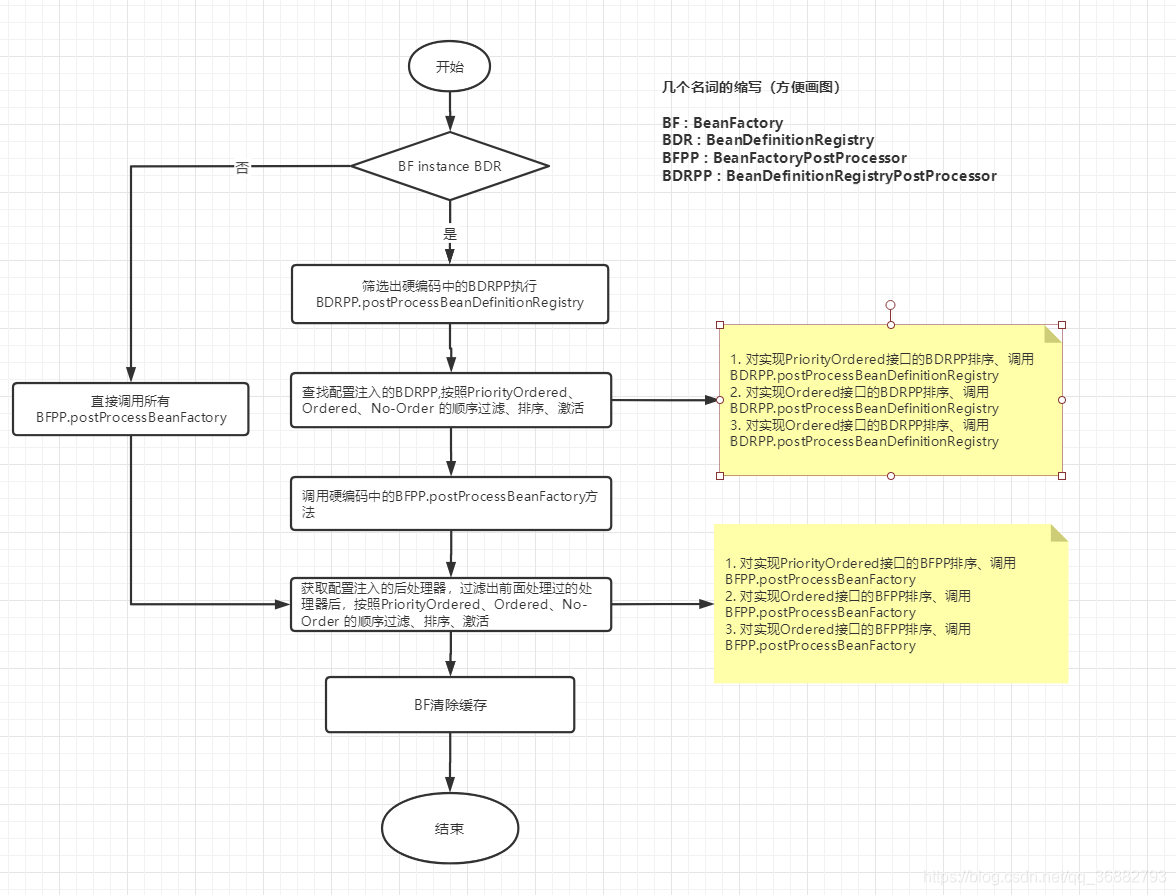本文分析的方法是 AbstractApplicationContext#invokeBeanFactoryPostProcessors,是 前篇内容的继续部分。
本文衍生篇:
Spring 源码分析衍生篇八 :ConfigurationClassPostProcessor 上篇
Spring 源码分析衍生篇九 :ConfigurationClassPostProcessor 下篇
PS : 个人感觉,实现IOC的两个核心后处理器 :
ConfigurationClassPostProcessor 解析配置类(这里的配置类不仅仅局限于@Configuration 注解,还包括 @Import、 @ImportResource 等注解),将解析到的需要注入到Spring容器中的bean的BeanDefinition保存起来
AutowiredAnnotationBeanPostProcessor 解析bean中的 需要自动注入的bean @Autowired 和 @Inject @Value注解。
BeanFactoryPostProcessor 相比较于 BeanPostProcessor 方法是很简单的,只有一个方法,其子接口也就一个方法。但是他们俩的功能又是类似的,区别就是作用域并不相同。BeanFactoryPostProcessor的作用域范围是容器级别的。它只和你使用的容器有关。如果你在容器中定义一个BeanFactoryPostProcessor ,它仅仅对此容器中的bean进行后置处理。BeanFactoryPostProcessor 不会对定义在另一个容器中的bean进行后置处理,即使这两个容器都在同一容器中。
BeanFactoryPostProcessor 可以对 bean的定义(配置元数据)进行处理。Spring IOC 容器允许 BeanFactoryPostProcessor 在容器实际实例化任何其他bean之前读取配置元数据,并有可能修改它,也即是说 BeanFactoryPostProcessor 是直接修改了bean的定义,BeanPostProcessor 则是对bean创建过程中进行干涉。
BeanDefinitionRegistryPostProcessor 和 BeanFactoryPostProcessor 的区别在于:
BeanDefinitionRegistryPostProcessor .postProcessBeanDefinitionRegistry 方法针对是BeanDefinitionRegistry类型的ConfigurableListableBeanFactory,可以实现对BeanDefinition的增删改查等操作,但是对于非 ConfigurableListableBeanFactory 类型的BeanFactory,并不起作用。BeanFactoryPostProcessor .postProcessBeanFactory 针对的是所有的BeanFactory。postProcessBeanDefinitionRegistry 的调用时机在postProcessBeanFactory 之前。
三、代码分析
1. BeanFactory
需要注意的是,我们这里的 BeanFactory 实际类型是 DefaultListableBeanFactory。这一点在 Spring源码分析一:容器的刷新 - refresh() 中已经得到证实。
下面我们看看 DefaultListableBeanFactory 的结构图如下,可以看到DefaultListableBeanFactory 实现了 BeanDefinitionRegistry 接口。这点在下面的分析中会用到。
为了更好的了解下面的代码,我们先了解几个代码中的规则:
BeanFactoryPostProcessor 在本次分析中分为两种类型: BeanFactoryPostProcessor 和其子接口 BeanDefinitionRegistryPostProcessor 。BeanDefinitionRegistryPostProcessor 相较于 BeanFactoryPostProcessor ,增加了一个方法如下。
public interface BeanDefinitionRegistryPostProcessor extends BeanFactoryPostProcessor {
/**
* Modify the application context's internal bean definition registry after its
* standard initialization. All regular bean definitions will have been loaded,
* but no beans will have been instantiated yet. This allows for adding further
* bean definitions before the next post-processing phase kicks in.
* @param registry the bean definition registry used by the application context
* @throws org.springframework.beans.BeansException in case of errors
*/
void postProcessBeanDefinitionRegistry(BeanDefinitionRegistry registry) throws BeansException;
}需要注意的是,BeanDefinitionRegistryPostProcessor#postProcessBeanDefinitionRegistry 这个方法仅仅针对于 BeanDefinitionRegistry 类型的 BeanFactory 生效,这一点根据其入参就可以看到。
总结一下即 : BeanFactoryPostProcessor 针对所有的 BeanFactory ,即对于所有类型的BeanFactory 都会调用其方法;BeanDefinitionRegistryPostProcessor 仅对 BeanDefinitionRegistry 子类的BeanFactory 起作用,非BeanDefinitionRegistry类型则直接处理即可。
BeanFactoryPostProcessor 的注入分为两种方式:
配置注入方式:即通过注解或者xml的方式动态的注入到容器中的BeanFactoryPostProcessor
硬编码注入方式: 这种方式是直接调用 AbstractApplicationContext#addBeanFactoryPostProcessor 方法将 BeanFactoryPostProcessor 添加到 AbstractApplicationContext#beanFactoryPostProcessors 属性中。其中
4. 硬编码注入的BeanFactoryPostProcessor 并不需要也不支持接口排序,而配置注入的方式因为Spring无法保证加载的顺序,所以通过支持PriorityOrdered、Ordered排序接口的排序。
5. 在下面代码分析中会由四个集合
1.regularPostProcessors : 记录通过硬编码方式注册的BeanFactoryPostProcessor 类型的处理器
2.registryProcessors:记录通过硬编码方式注册的BeanDefinitionRegistryPostProcessor 类型的处理器
3.currentRegistryProcessors : 记录通过配置方式注册的 BeanDefinitionRegistryPostProcessor 类型的处理器
processedBeans : 记录当前已经处理过的BeanFactoryPostProcessor 和 BeanDefinitionRegistryPostProcessor
其实调用顺序可以归纳为: 硬编码先于配置,postProcessBeanDefinitionRegistry 先于postProcessBeanFactory
下面我们来看具体代码:
AbstractApplicationContext#invokeBeanFactoryPostProcessors 方法内容如下
protected void invokeBeanFactoryPostProcessors(ConfigurableListableBeanFactory beanFactory) {
/**
* getBeanFactoryPostProcessors获取自定义的beanFactoryPostProcessor
* 何为自定义?
* 不通过注解形式扫描获取
* 而是通过手动context.addBeanFactoryPostProcessor(beanFactoryPostProcessor)完成自定义
*
* getBeanFactoryPostProcessors默认是个空的List
*/
PostProcessorRegistrationDelegate.invokeBeanFactoryPostProcessors(beanFactory, getBeanFactoryPostProcessors());
// Detect a LoadTimeWeaver and prepare for weaving, if found in the meantime
// (e.g. through an @Bean method registered by ConfigurationClassPostProcessor)
/**
* 如果发现loadTimeWeaver的Bean
* 添加BeanPostProcessor->LoadTimeWeaverAwareProcessor
*/
if (beanFactory.getTempClassLoader() == null && beanFactory.containsBean(LOAD_TIME_WEAVER_BEAN_NAME)) {
beanFactory.addBeanPostProcessor(new LoadTimeWeaverAwareProcessor(beanFactory));
beanFactory.setTempClassLoader(new ContextTypeMatchClassLoader(beanFactory.getBeanClassLoader()));
}
}可以看到主要功能还是在PostProcessorRegistrationDelegate.invokeBeanFactoryPostProcessors(beanFactory, getBeanFactoryPostProcessors()); 这一句上。我们先来看看 getBeanFactoryPostProcessors() 得到的是什么
private final List<BeanFactoryPostProcessor> beanFactoryPostProcessors = new ArrayList<>();
@Override
public void addBeanFactoryPostProcessor(BeanFactoryPostProcessor postProcessor) {
Assert.notNull(postProcessor, "BeanFactoryPostProcessor must not be null");
this.beanFactoryPostProcessors.add(postProcessor);
}
/**
* Return the list of BeanFactoryPostProcessors that will get applied
* to the internal BeanFactory.
*/
public List<BeanFactoryPostProcessor> getBeanFactoryPostProcessors() {
return this.beanFactoryPostProcessors;
}
2.2 invokeBeanFactoryPostProcessors
通过上一步,我们可以知道 入参中的 beanFactoryPostProcessors 集合是硬编码注册的 集合。对于下面的分析我们就好理解了。
下面代码主要是对于 BeanDefinitionRegistry 类型 BeanFactory的处理以及 BeanFactoryPostProcessor 调用顺序问题的处理。实际上并不复杂。
public static void invokeBeanFactoryPostProcessors(
ConfigurableListableBeanFactory beanFactory, List<BeanFactoryPostProcessor> beanFactoryPostProcessors) {
// Invoke BeanDefinitionRegistryPostProcessors first, if any.
Set<String> processedBeans = new HashSet<>();
// 对BeanDefinitionRegistry类型的处理,这里是交由BeanDefinitionRegistryPostProcessor来处理
// 这里判断BeanFactory 如果是 BeanDefinitionRegistry 子类 则需要进行BeanDefinitionRegistryPostProcessor 的处理,否则直接按照 BeanFactoryPostProcessor处理即可。
// 关于为什么BeanDefinitionRegistry 比较特殊上面也说过,因为BeanDefinitionRegistryPostProcessor 只能处理 BeanDefinitionRegistry 的子类,所以这里需要区分是否是 BeanDefinitionRegistry 类型
if (beanFactory instanceof BeanDefinitionRegistry) {
// 下面逻辑看似复杂,其实就两步:
// 1. 获取所有硬编码的 BeanDefinitionRegistryPostProcessor 类型,激活postProcessBeanDefinitionRegistry 方法
// 2. 获取所有配置的BeanDefinitionRegistryPostProcessor,激活postProcessBeanDefinitionRegistry 方法
BeanDefinitionRegistry registry = (BeanDefinitionRegistry) beanFactory;
// 记录通过硬编码方式注册的BeanFactoryPostProcessor 类型的处理器
List<BeanFactoryPostProcessor> regularPostProcessors = new ArrayList<>();
// 记录通过硬编码方式注册的BeanDefinitionRegistryPostProcessor 类型的处理器
List<BeanDefinitionRegistryPostProcessor> registryProcessors = new ArrayList<>();
// 遍历硬编码注册的后处理器(都保存AbstractApplicationContext#beanFactoryPostProcessors 中,这里通过参数beanFactoryPostProcessors传递过来)
for (BeanFactoryPostProcessor postProcessor : beanFactoryPostProcessors) {
if (postProcessor instanceof BeanDefinitionRegistryPostProcessor) {
BeanDefinitionRegistryPostProcessor registryProcessor =
(BeanDefinitionRegistryPostProcessor) postProcessor;
// 激活 硬编码的处理器的BeanDefinitionRegistryPostProcessor.postProcessBeanDefinitionRegistry 方法。
registryProcessor.postProcessBeanDefinitionRegistry(registry);
// 保存到 registryProcessors中
registryProcessors.add(registryProcessor);
}
else {
// 非BeanDefinitionRegistryPostProcessor 类型的硬编码注入对象 保存到regularPostProcessors中
regularPostProcessors.add(postProcessor);
}
}
// Do not initialize FactoryBeans here: We need to leave all regular beans
// uninitialized to let the bean factory post-processors apply to them!
// Separate between BeanDefinitionRegistryPostProcessors that implement
// PriorityOrdered, Ordered, and the rest.
// 记录通过配置方式注册的 BeanDefinitionRegistryPostProcessor 类型的处理器
List<BeanDefinitionRegistryPostProcessor> currentRegistryProcessors = new ArrayList<>();
// 获取所有的配置的 BeanDefinitionRegistryPostProcessor 的beanName
String[] postProcessorNames =
beanFactory.getBeanNamesForType(BeanDefinitionRegistryPostProcessor.class, true, false);
// 筛选出 PriorityOrdered 接口的实现类,优先执行
for (String ppName : postProcessorNames) {
if (beanFactory.isTypeMatch(ppName, PriorityOrdered.class)) {
// 记录到currentRegistryProcessors中
currentRegistryProcessors.add(beanFactory.getBean(ppName, BeanDefinitionRegistryPostProcessor.class));
processedBeans.add(ppName);
}
}
// 进行排序
sortPostProcessors(currentRegistryProcessors, beanFactory);
registryProcessors.addAll(currentRegistryProcessors);
// 激活 postProcessBeanDefinitionRegistry 方法
invokeBeanDefinitionRegistryPostProcessors(currentRegistryProcessors, registry);
currentRegistryProcessors.clear();
// Next, invoke the BeanDefinitionRegistryPostProcessors that implement Ordered.
postProcessorNames = beanFactory.getBeanNamesForType(BeanDefinitionRegistryPostProcessor.class, true, false);
// 筛选出 Ordered 接口的实现类,第二执行
for (String ppName : postProcessorNames) {
if (!processedBeans.contains(ppName) && beanFactory.isTypeMatch(ppName, Ordered.class)) {
currentRegistryProcessors.add(beanFactory.getBean(ppName, BeanDefinitionRegistryPostProcessor.class));
processedBeans.add(ppName);
}
}
// 排序
sortPostProcessors(currentRegistryProcessors, beanFactory);
registryProcessors.addAll(currentRegistryProcessors);
// 激活
invokeBeanDefinitionRegistryPostProcessors(currentRegistryProcessors, registry);
currentRegistryProcessors.clear();
// Finally, invoke all other BeanDefinitionRegistryPostProcessors until no further ones appear.
// 最后获取没有实现排序接口的 BeanDefinitionRegistryPostProcessor ,进行激活。
boolean reiterate = true;
while (reiterate) {
reiterate = false;
postProcessorNames = beanFactory.getBeanNamesForType(BeanDefinitionRegistryPostProcessor.class, true, false);
for (String ppName : postProcessorNames) {
if (!processedBeans.contains(ppName)) {
currentRegistryProcessors.add(beanFactory.getBean(ppName, BeanDefinitionRegistryPostProcessor.class));
processedBeans.add(ppName);
reiterate = true;
}
}
// 排序
sortPostProcessors(currentRegistryProcessors, beanFactory);
registryProcessors.addAll(currentRegistryProcessors);
// 激活
invokeBeanDefinitionRegistryPostProcessors(currentRegistryProcessors, registry);
currentRegistryProcessors.clear();
}
// 到这里,所有的 BeanDefinitionRegistryPostProcessor 的postProcessBeanDefinitionRegistry 都已经激活结束,开始激活 postProcessBeanFactory 方法
// registryProcessors 记录的是硬编码注入的BeanDefinitionRegistryPostProcessor,这里激活的是 postProcessBeanFactory 方法
invokeBeanFactoryPostProcessors(registryProcessors, beanFactory);
// regularPostProcessors 中记录的是 硬编码注入的 BeanFactoryPostProcessor
invokeBeanFactoryPostProcessors(regularPostProcessors, beanFactory);
}
else {
// Invoke factory processors registered with the context instance.
// 如果 beanFactory instanceof BeanDefinitionRegistry = false,那么BeanDefinitionRegistryPostProcessor.的postProcessBeanDefinitionRegistry 并不生效,就直接激活postProcessBeanFactory方法即可。
// 激活 硬编码注册的 BeanFactoryPostProcessor.postProcessBeanFactory 方法
invokeBeanFactoryPostProcessors(beanFactoryPostProcessors, beanFactory);
}
// 到这一步,所有的硬编码方式注入的后处理器都处理完毕,下面开始处理配置注入的后处理器。
// 获取所有后处理器的beanName,用于后面处理
String[] postProcessorNames =
beanFactory.getBeanNamesForType(BeanFactoryPostProcessor.class, true, false);
// Separate between BeanFactoryPostProcessors that implement PriorityOrdered,
// Ordered, and the rest.
// 创建几个保存不同排序的集合,按照实现的排序接口调用
List<BeanFactoryPostProcessor> priorityOrderedPostProcessors = new ArrayList<>();
List<String> orderedPostProcessorNames = new ArrayList<>();
List<String> nonOrderedPostProcessorNames = new ArrayList<>();
for (String ppName : postProcessorNames) {
if (processedBeans.contains(ppName)) {
// skip - already processed in first phase above
}
else if (beanFactory.isTypeMatch(ppName, PriorityOrdered.class)) {
priorityOrderedPostProcessors.add(beanFactory.getBean(ppName, BeanFactoryPostProcessor.class));
}
else if (beanFactory.isTypeMatch(ppName, Ordered.class)) {
orderedPostProcessorNames.add(ppName);
}
else {
nonOrderedPostProcessorNames.add(ppName);
}
}
// First, invoke the BeanFactoryPostProcessors that implement PriorityOrdered.
// 排序激活 PriorityOrdered 接口的 后处理器
sortPostProcessors(priorityOrderedPostProcessors, beanFactory);
invokeBeanFactoryPostProcessors(priorityOrderedPostProcessors, beanFactory);
// Next, invoke the BeanFactoryPostProcessors that implement Ordered.
// 排序激活 Ordered 接口的 后处理器
List<BeanFactoryPostProcessor> orderedPostProcessors = new ArrayList<>(orderedPostProcessorNames.size());
for (String postProcessorName : orderedPostProcessorNames) {
orderedPostProcessors.add(beanFactory.getBean(postProcessorName, BeanFactoryPostProcessor.class));
}
sortPostProcessors(orderedPostProcessors, beanFactory);
invokeBeanFactoryPostProcessors(orderedPostProcessors, beanFactory);
// Finally, invoke all other BeanFactoryPostProcessors.
// 排序激活 没有实现排序接口的 后处理器
List<BeanFactoryPostProcessor> nonOrderedPostProcessors = new ArrayList<>(nonOrderedPostProcessorNames.size());
for (String postProcessorName : nonOrderedPostProcessorNames) {
nonOrderedPostProcessors.add(beanFactory.getBean(postProcessorName, BeanFactoryPostProcessor.class));
}
invokeBeanFactoryPostProcessors(nonOrderedPostProcessors, beanFactory);
// Clear cached merged bean definitions since the post-processors might have
// modified the original metadata, e.g. replacing placeholders in values...
// 清除缓存。
beanFactory.clearMetadataCache();
}


